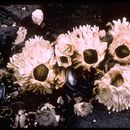en
names in breadcrumbs


The clade[1][2][3][4] Multicrustacea constitutes the largest superclass of crustaceans, containing approximately four-fifths of all described crustacean species, including crabs, lobsters, crayfish, shrimp, krill, prawns, woodlice, barnacles, copepods, amphipods, mantis shrimp and others. The largest branch of multicrustacea is the class Malacostraca (see below).
Superclass Multicrustacea Regier, Shultz, Zwick, Hussey, Ball, Wetzer, Martin & Cunningham, 2010 [5]
Notes:
Sacculina Sacculina carcini (Rhizocephala) parasite of a crab.
Anew Lepas anatifera (Lepadiformes)
Balth Chthamalus stellatus (Sessilia)
Inch-foot Pollicipes polymerus (Scalpelliformes)
Amphionides reynaudii , the unique Amphionidacea known.
Crab Cancer bellianus (Eucarida)
Antarctic Krill Euphausia superba (Euphausiacea)
The clade Multicrustacea constitutes the largest superclass of crustaceans, containing approximately four-fifths of all described crustacean species, including crabs, lobsters, crayfish, shrimp, krill, prawns, woodlice, barnacles, copepods, amphipods, mantis shrimp and others. The largest branch of multicrustacea is the class Malacostraca (see below).